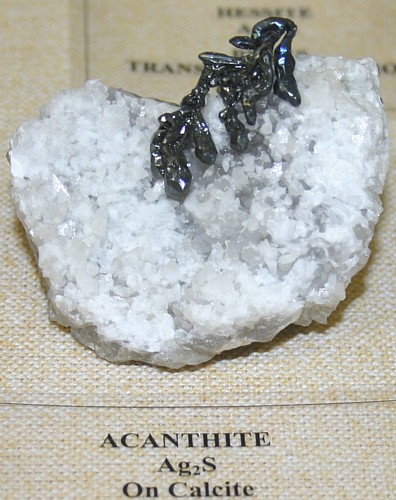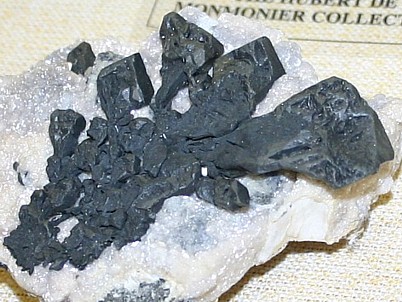|
.
Acanthite Mineral Facts:
Chemical
Formula: Ag2S (Previously
known as Argentite) 87.1% Silver by weight
Colors:
Mineral and streak are blackish to
lead-gray. Streak sometimes has metallic shine.
Hardness:
2.0 to 2.5
Hardness varies somewhat depending
on formation and impurities.
Density: 7.3
The density
is high because of the large silver content.
Cleavage:
Imperfect,
but
it is easily sectile, and can be cut with a knife like lead.
Crystallography: Monoclinic
Luster:.
Metallic luster. Easily
sectile, and can be cut with a knife like lead.
Optics:
(Refractive Index): Opaque
|
 |
|
Composition,
Structure and Associated Minerals:
Acanthite, though not very widespread in its occurrence, is an important
silver ore. It is found in masses, as coatings, and in crystals or arborescent groups of crystals. Acanthite is usually, however, impure
through the admixture of small quantities of Fe, Pb, Cu, etc.
It is most commonly found as
massive, platy, earthy forms or as a coating on other rocks. Well formed
crystals are fairly rare.
The crystals are often distorted and grouped into parallel growths of
different shapes. Twinning is common, with P(111) the twinning plane. The
twins are usually penetration twins. The habit of most crystals appears
cubical because of twinning, but are actually monoclinic.
Identification and Diagnostics
Easily fusible at
1.5 with intumescence. When fused alone on charcoal in an open flame, it
gives off odor of sulphur dioxide and yields a globule of pure silver.
Distinguished by these tests and by its color, sectility and high specific
gravity.
It is soluble
in nitric acid.
Occurrence,
Localities and Origins:
A
fairly common ore of silver. Usually found in silver veins as small masses,
often earthy or as a coating. Associated with native silver, the ruby
silvers,
stephanite and other silver minerals as well as other
sulfides such
as
galena. The mineral is found in the
secondary enrichment zones of veins associated with silver and other
sulfides in many silver-mining districts. In Nevada it is an important ore
at the Comstock lode, Tonopah and in the Cortez district. It is found also
near Port Arthur on the north shore of Lake Superior, in Ontario, and
associated with
native silver in the copper mines of Michigan. The rich
silver ores of Mexico, Chile, Bolivia and Peru are composed largely of this
mineral. Important European localities for its
occurrence are Freiberg in Saxony, Annaberg in Austria, Joachimsthal in
Bohemia, Schemnitz and Kremnitz in Hungary and Kongsberg in Norway.
Much of the silver produced in the US country
was obtained from acanthite, though by no means so great a quantity as is
obtained from other sources. Still, it is an
important
ore of silver.
Return to the
Mineral Collectors Information Page |

Acanthite, Earthy Form |
|



